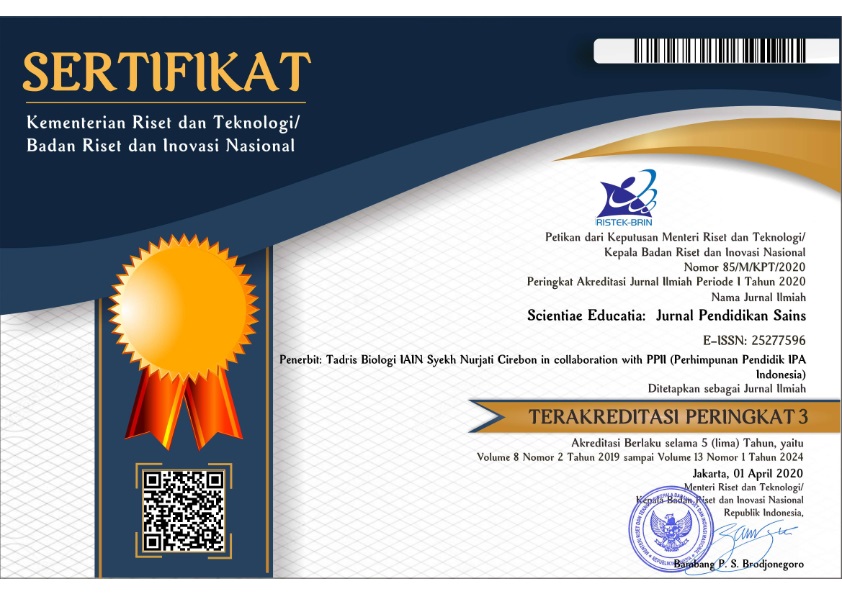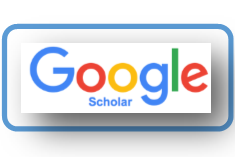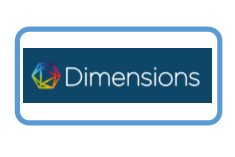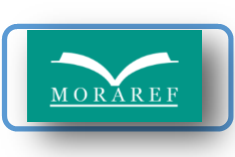Analysis of Biology Textbook Class X 2013 Curriculum Based on Science Literacy Category Integrated Islamic Values in the Concept of Environmental Change
(1) Department of Biology Education, Faculty of Education and Teacher Training, IAIN Syekh Nurjati Cirebon
(2) Department of Biology Education, Faculty of Education and Teacher Training, IAIN Syekh Nurjati Cirebon
(3) Department of Biology Education, Faculty of Education and Teacher Training, IAIN Syekh Nurjati Cirebon
(*) Corresponding Author
Abstract
Keywords
Full Text:
PDFReferences
Abd-El-Khalick, F., Myers, J. Y., Summers, R., Brunner, J., Waight, N., Wahbeh, N., Belarmino, J. (2016). A longitudinal analysis of the extent and manner of representations of nature of science in US high school biology and physics textbooks. Journal of Research in Science Teaching, 54(1), 82–120.
Abidin, Z. (2005). Integration of Science and religion: Interpretation and action. Mizan.
Abidinsyah. (2016). 2013 Curriculum as an Embodiment of character constructive dynamics. Florea's Journal, 3(2), 1-8.
Akcay, H., Ozgur K. H., & E. Yager, R. (2017) using newspaper and advertisement to focus on science teaching and learning. Universal Journal of Educational Research, 5(1), 99-103.
Al-Mommani, F. N. N. (2016). Assessing the development of scientific literacy among undergraduates' college education. Journal of studies in education 6(2), 199-212.
Anisa, A. (2017). The effect of using textbooks and the internet as learning resources on student learning outcomes for social studies subjects. Scientific Journal of Lemlit Unswagati Cirebon 18(3): 1-18
Arifin, Z. (2011). Concepts and models of curriculum development. Rosdakarya Teenagers
Asyhari, A. (2015) Profile of increasing students' scientific literacy skills through scientific learning. Scientific journal of physics education Al-Biruni, 4(2), 179-191.
Aqil, D. I. (2017). Scientific literacy as a learning concept for biology textbooks in schools. Didactic Discourse, 5(2) 160-171.
Chiappetta, E. L., Sethna, G. H., & Fillman, D. A. (1991). A qualitative analysis of high school chemistry textbooks for scientific literacy themes and expository learning aids. Journal or Research in Science Teaching, 28, 939–951.
Chiappetta, E. L., & Fillman, D. A. (2007). Analysis of five high school biology textbooks used in the united states for inclusion of the nature of science. International Journal of Science Education 28(15), 1847-1868.
Diani, R., & Hartati, N. S. (2018). Islamic literacy-based flipbook: Development of physics learning media with professional 3D page flip. Journal of Science Education Innovation, 4(2), 234-244.
Chonkaew, P., Sukhummek, B. & Faikhamta, C. (2016). Development of analytical thinking abilities and attitudes towards science learning of grade-11 students through science technology engineering and mathematics (STEM Education) in the study stoichiometry. Chemistry education research and practice, 17 (4). 842- 861
Ekohariadi. (2009). Factors affecting 15-Year-Old Indonesian scientific literacy. Journal of Basic Education, 10(1) 28-41.
Fauziah, R., Abdullah, A. G., & Hakim, D., L., (2013). Scientific learning of basic electronics is oriented to problem-based learning. Invotec, 9(2).
Frydenberg, M. & One, D. (2011). Learning for 21st Century Skills 314- 31
Hidayat, S. (2013). New curriculum development. Rosdakarya Youth.
Mulyana, R. (2004). Articulating values education. Alfabeta
Muspiroh, N. (2013). Integration of Islamic Values in science learning (Islamic Education Perspective). Journal of Islamic Education UIN Sunan Gunung Djati 28(3),1-15.
OECD. (2019). PISA 2018: Insight interpretation. OECD Publishing
Prastowo, A. (2011). A creative guide to making innovative teaching materials. Diva Press
Raharjo, M. W. C., Suryati, S., & Khery, Y., (2017). The development of interactive e-modules using adobe flash on chemical bonding materials to encourage students' scientific literacy. Hydrogen: Journal of Chemistry Education, 5(1) 8-13.
Risma, M., Rahmayani, R., & Handayani, F., (2019). The content analysis of integrated science textbooks for class VIII semester 1 is viewed from the aspect of scientific literacy. Journal of Exact Education (JEP), 3(2).
Shehab, S. S., & Boujaoude, S. (2017). Analysis of the chemical representation in secondary Lebanese chemistry textbooks. International journal of science and mathematics education, 15(5), 797-816
Sholeh, M. I. (2018). Development of integrated socio-scientific (SSI) and Islamic basic chemistry learning modules. Orbital: Journal of Chemistry Education, 2(2): 37-57.
Udeani, U. (2013). Quantitative analysis of secondary school biology textbooks for scientific literacy themes. Research Journal in Organizational Psychology & Education Studies, 2 (1): 39-43.
Warningsih, S., Santoso, H., & Lepiyanto, A. (2019). Development of scientific literacy-based modules with integrated Islamic values in the biodiversity material for Class X High School in Proceedings of the National Biology Seminar Vol 5 No 1.
Wati, F., Sinaga, P., & Priyandoko, D. (2017). Science Literacy: How do High School Students Solve PISA Test Items? Journal of Physics: Conf. Series 895 012166, 1–6.
Wati, L., & Yuni, F. (2018). The design of teaching materials in the form of guided inquiry-based handouts in the learning of chemistry of hydrocarbon materials. Journal of Applied and Chemical Education, 1(2): 219-224.
DOI: 10.24235/sc.educatia.v10i2.9079
Article Metrics
Abstract view : 0 timesPDF - 0 times
Refbacks
- There are currently no refbacks.
Scientiae Educatia: Jurnal Pendidikan Sains indexed by:

This work is licensed under a Creative Commons Attribution 4.0 International License.
Stat Counter (Link)

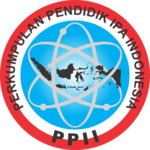

1.png)
